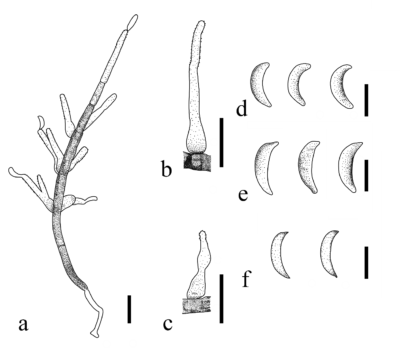Fungalpedia – Note 183, Brachiampulla
Brachiampulla Réblová & Hern. -Restr.
Citation when using this entry: Li et al. 2024 (in prep) – Fungalpedia. Xylariomycetidae.
Index Fungorum, Facesoffungi, MycoBank, GenBank, Fig. 1
Classification: Xyladictyochaetaceae, Xylariales, Xylariomycetidae, Sordariomycetes, Pezizomycotina, Ascomycota, Fungi
Brachiampulla was established by Réblová et al. (2021) with B. verticillata as the type species based on morphological and phylogenetic analyses of combined ITS, LSU, SSU, tef1-α, and rpb2 sequence data. The type species was isolated as a Saprobe on fallen leaves of Nothofagus fusca (Nothofagaceae) from the Bay of Plenty in New Zealand. Brachiampulla is a monotypic genus and characterized by macronematous, mononematous, erect, setiform, unbranched, pigmented conidiophores; indeterminate polyphialidic, discrete, lateral, integrated conidiogenous cells; hyaline, aseptate, lunate, hyaline conidia aggregated in slimy heads (Réblová et al. 2021). Only one species is listed in Index Fungorum (2023).
Type species: Brachiampulla verticillata (B. Sutton & Hodges) Réblová & Hern.-Restr.
Basionym: Selenosporella verticillata B. Sutton & Hodges 1978
Figure 1 – Brachiampulla verticillata a Conidiophores. b, c Details of conidiogenous cells. d–f Conidia. Scale bars: a = 10 μm, b–c = 10 μm, e = 10 μm, d, f = 5 μm. Redrawn from Réblová et al. (2021).
References
Entry by
Yanxia Li, Innovative Institute for Plant Health/ Key Laboratory of Green Prevention and Control on Fruits and Vegetables in South China, Ministry of Agriculture and Rural Affairs, Zhongkai University of Agriculture and Engineering, Guangzhou, 510225, China.
(Edited by Mingkwan Doilom, Samaneh Chaharmiri-Dokhaharani, & Achala R. Rathanayaka)
Published online 18 January 2024
